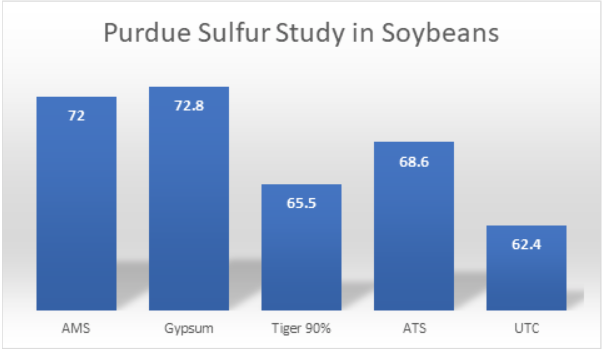Update from the Field: Satisfaction
Posted on November 22, 2019

When it comes to applying sulfur or sulfates, the Rolling Stones said it best, “I can't get no satisfaction.” In the past, atmospheric deposition of sulfur from the burning of high sulfur coal and diesel provided enough sulfur to satisfy crop needs. The Clean Air Act of 1963 led to a decrease in air pollution and the conversion of power plants from coal to natural gas, greatly reducing sulfur deposition into the atmosphere. As a result, less sulfur is being deposited into the soil through rainwater, Figure 1. With less sulfur in the soil, there is an increased possibility of sulfur deficiency in crops. According to the A&L Great Lakes Labs 2018 Soil Test Summary, close to 40% of all soils tested in OH, MI, IN, IL, and WI, were low to very low in sulfur.

Figure 1: Map showing sulfur deposited through rainwater in the years 1984-1986 vs 2012-2014.
Only a few pounds of organic sulfur are available to the crop every year through mineralization of the organic matter. According to research by Dr. Shaun Casteel (Purdue University Associate Professor of Agronomy), at least 20 pounds of sulfate are needed prior to planting to reach our optimum yield. So, to find out how to make up the balance we need to look at a three-step approach. We need to set the stage by applying 90% sulfur with our dry fertilizer at a rate of 12lb/ac. In a study conducted in Indiana in 2019, a nine bushel increase in corn was observed when 12lb/ac of 90% sulfur was applied in the fall, Figure 2. Elemental sulfur (S) must be converted to sulfate (SO4- -) to be available to the crop, which can take up to six months.


Figure 2: This study was observed in Silver Lake, IN. The 90% sulfur was applied with the fall fertilizer in the fall of 2018 at a rate of 12lb/ac and harvested in the fall of 2019. The check just had fertilizer applied. The variety was the same across the trial.
Purdue University has shown a benefit by adding gypsum (CaSO₄ • 2H₂0), like The Andersons’ NutraSoft® DG, at a rate of 200lb/ac. This next step of adding gypsum in the spring, prior to planting, can increase soybean production by up to 10 bu/ac over the untreated check (UTC), Figure 3. As you can see in the Purdue study, elemental sulfur (S) is ineffective in a spring application as it takes too long to break down and transform into sulfate (SO4--), the nutrient the plants crave.

Figure 3: This sulfate study was observed by Purdue University at the Pinney Research Farm outside Wanatah, IN. It takes a while for sulfur(S) to transform into sulfates (SO4--), making a sulfate source like gypsum an excellent option for spring application.
The third step to gain your optimum yield from a sulfur application should consist of sulfur in your starter. Applying sulfur in the starter will allow the plant to absorb more of the nutrient because of the concentrated nature of starter. It will also drop the pH around the root system, allowing more nutrients to become available. The amount of sulfur in your starter application will be contingent on the placement of the starter with relation to the seed. The closer your starter is placed to the seed, the less sulfur you need to have in the starter solution. An in-furrow application of starter will only need a 1% solution of sulfur to show good results. However, in a 2x2 starter application, you will need a 3% sulfur solution to have the same effect.
In conclusion, we have cleaned up the air in the Corn Belt which is good news for our lungs but bad news for our crops. As we continue to deplete our soils of sulfur and sulfates (SO4--) we need to be looking at applying this essential nutrient back into our cropping systems. We must put back what we take off if continued yield increases are our goal.
FOR MORE INFORMATION:
Please complete the form, and we’ll get you in touch with your Territory Manager from The Andersons.

Dave Dyson is a regional agronomist for The Andersons’ Farm Centers which are located throughout Ohio, Michigan, and Indiana. He is an Indiana native and grew up on a dairy farm in Miami County. A graduate of Purdue University with a degree in Crop & Soil Science, Dave has a deep knowledge of various agronomic topics and is committed to helping growers improve their crops. If you have any questions, Dave can be reached at david_dyson@andersonsinc.com.
© 2019 The Andersons, Inc. All Rights Reserved. NutraSoft is a registered trademark of The Andersons, Inc.
.


